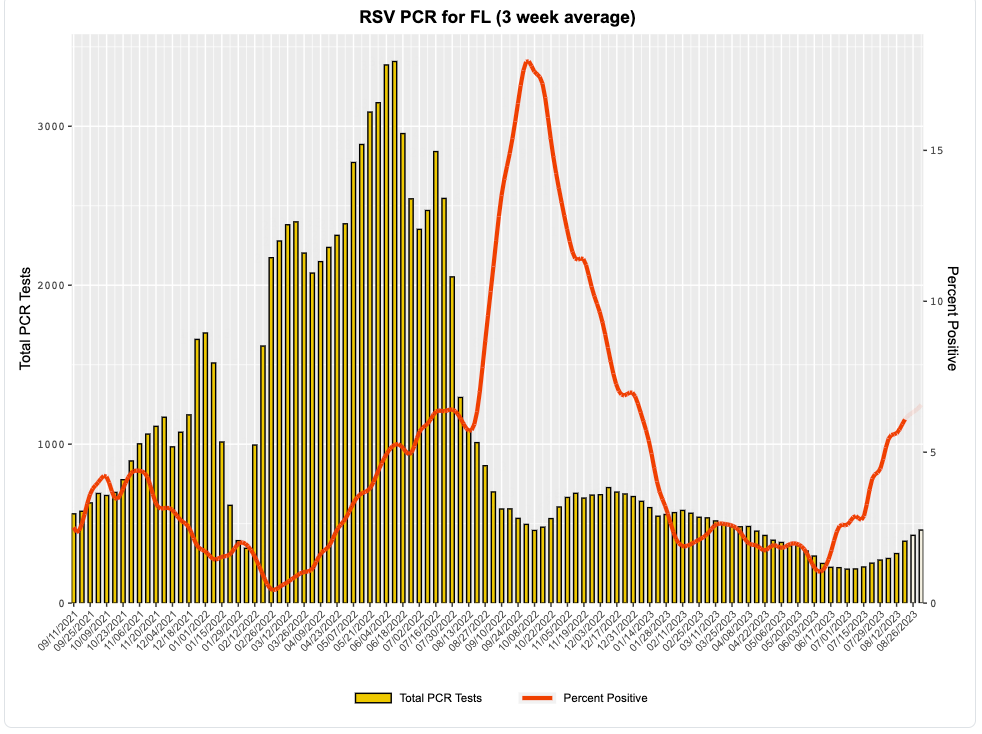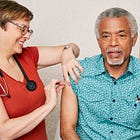This week in outbreaks: September 14 edition
The latest on influenza-like illness, Covid-19, RSV and more
Starting October 2nd, paying subscribers will receive exclusive access to regional editions of "This Week in Outbreaks." Just like my weekly national updates, these specialized editions will provide in-depth information on respiratory diseases including Covid-19, influenza-like illnesses, and RSV. I will also cover stomach bugs and food recalls. What sets this apart? The data you receive will be tailored to your region so you can be informed about what's happening in your area. To learn more, see my recent announcement:
Respiratory diseases
Influenza-like illness (ILI) rose slightly during the last reporting period to 1.9% of visits to the doctor for fever and cough or sore throat, inching us closer to the start of flu season. Much of the South now rates as “mild” for ILI activity, up from “minimal.” Young children continue to be particularly affected, with the most recent report showing an increase in ILI activity in children aged 0-4 from 5.8% to 6.2%. While all other age groups experienced a slight increase, it was less significant.
Many state health departments will activate their flu surveillance systems in October, which is one way to mark the beginning of the flu season. The other is when ILI activity crosses the threshold of 2.5% of visits to the doctor for ILI. (We are at 1.9%, so not there yet. )Last year we crossed that line in early October, but most years it doesn’t happen until November or even December. As the name suggests, influenza-like illness surveillance is not specific to influenza. Any visit to the doctor for fever and cough or sore throat qualifies, so it can be a mix of bugs.

Covid-19 hospitalizations rose again this week to 18,871, up from 17,360 last week. That’s about a 9% increase, which is lower than the 16% increase the week prior. For context, current hospitalization levels are half of those from the same time last year.
On the bright side, there may finally be signs that the summer wave is slowing. Both test positivity rates and the percentage of Emergency Department visits diagnosed as Covid-19 have slightly decreased, marking the first drop since June. Notably, improvements are finally evident in the Southern region. Wastewater concentration fell last week according to data from Biobot, and the number of new hospitalizations either plateaued or dropped in Florida, Georgia, and North Carolina. A single week of easing is not enough to say the tides have changed, but I’m hopeful.
And just to set expectations, the “end” of the summer wave doesn’t mean peace and quiet. In years prior, activity rose in the summer, dropped slightly but remained elevated through the winter months, and culminated in a peak around January.

The Food and Drug Administration approved Covid-19 boosters for the fall earlier this week. The decision then went to the Centers for Disease Control and Prevention, which recommended that everyone aged 6 months and older receive the shot. Only the Pfizer and Moderna mRNA products were approved. Novavax is still in review. The vaccines are already available on the shelves of some pharmacies and are expected to be widely available next week. Canadian authorities have also authorized the booster for everyone 6 months and older.
There has been some discussion in the news about whether young, healthy adults should bother with the booster, given that they are at low risk of severe illness. My opinion is yes! I would get a booster if I hadn't recently recovered. Given my recent infection, I’ll wait at least 3 months.
RSV is definitely gearing up in certain parts of the country. The Southern region got an early start this year, and according to the latest CDC report, activity there continues to increase. In Florida, for example, trends are looking similar to last year’s significant wave. Activity in Georgia, Alabama, Texas, and other Southern states is also increasing steadily.

The Northeastern region (notably Massachusetts) is also starting to heat up, and I’m seeing some signs on the West Coast as well. Activity in these regions is just beginning, so it’s not yet as pronounced as in the South.
RSV, or respiratory syncytial virus, is a major cause of respiratory illness in young children and older adults. This is the first year that shots are available to protect infants and adults over the age of 60. If you’re thinking of getting one, consider doing it sooner rather than later — especially if you live in the South.
Food recalls (updates on Wednesday)
The following foods are being recalled because they are contaminated. Please check your cupboards and throw out any of these items:
New:
None
Previously reported:
Life Raft Treats, “Not Fried Chicken” and “Life is Peachy” products (more info)
Dozens of products by Ice Cream House, dairy and non-dairy frozen dessert products, sold in New York, New Jersey and Ohio (more info)
Hillshire Brands smoked sausage (more info)
Banquet Chicken Strips Meal (more info)
Frozen corn and mixed vegetables from Food Lion and Kroger (more info)
Dehumidifiers, dozens of models sold by major retailers, including Home Depot, Lowe’s, and Walmart. The recalled units were manufactured between 2011 and 2014 (more info — check this list carefully, it’s extensive)
If you have food allergies, you may wish to review these FDA safety alerts and USDA alerts for foods with undeclared allergens.
In other news
Avian influenza A(H5N1) continues to circulate in birds and, occasionally, in mammals. In an August update, the World Organization for Animal Health (WOAH) reported nearly 200 outbreaks in approximately 20 countries. Animal influenza experts are worried that the virus could reach Antarctica, home to 100 million breeding birds. Apart from these devastating animal impacts, the primary concern with H5N1 is that it will evolve to become better at spreading between humans. So far, human cases are rare.
You may have heard about the latest Covid variant in the news, BA.2.86, which continues to confound experts, including me. BA.2.86, which contains around 30 mutations, was detected nearly simultaneously in multiple countries. The last time we saw that, we got the Omicron variant of 2021. With that in mind, scientists are working to determine if the variant poses a threat above and beyond what we see in the usual milieu. So far, the data are inconclusive. Early scientific studies are returning mixed results in experiments to determine whether the variant spreads more easily or evades immunity. However, I’m heartened that it hasn’t raced to dominance. This suggests it might not be as dangerous as initially feared.








Hello Caitlin,
As far as getting the booster, I'll be doing the thing you mentioned. All 4 of us (me, my wife & our 2 sons) got covid early last month. My wife and our sons tested negative on the 11th, & I tested negative on the 13th. So we're going to wait until late Nov & get the booster then.
G
Extremely grateful for these newsletters. I recommend them to everyone.